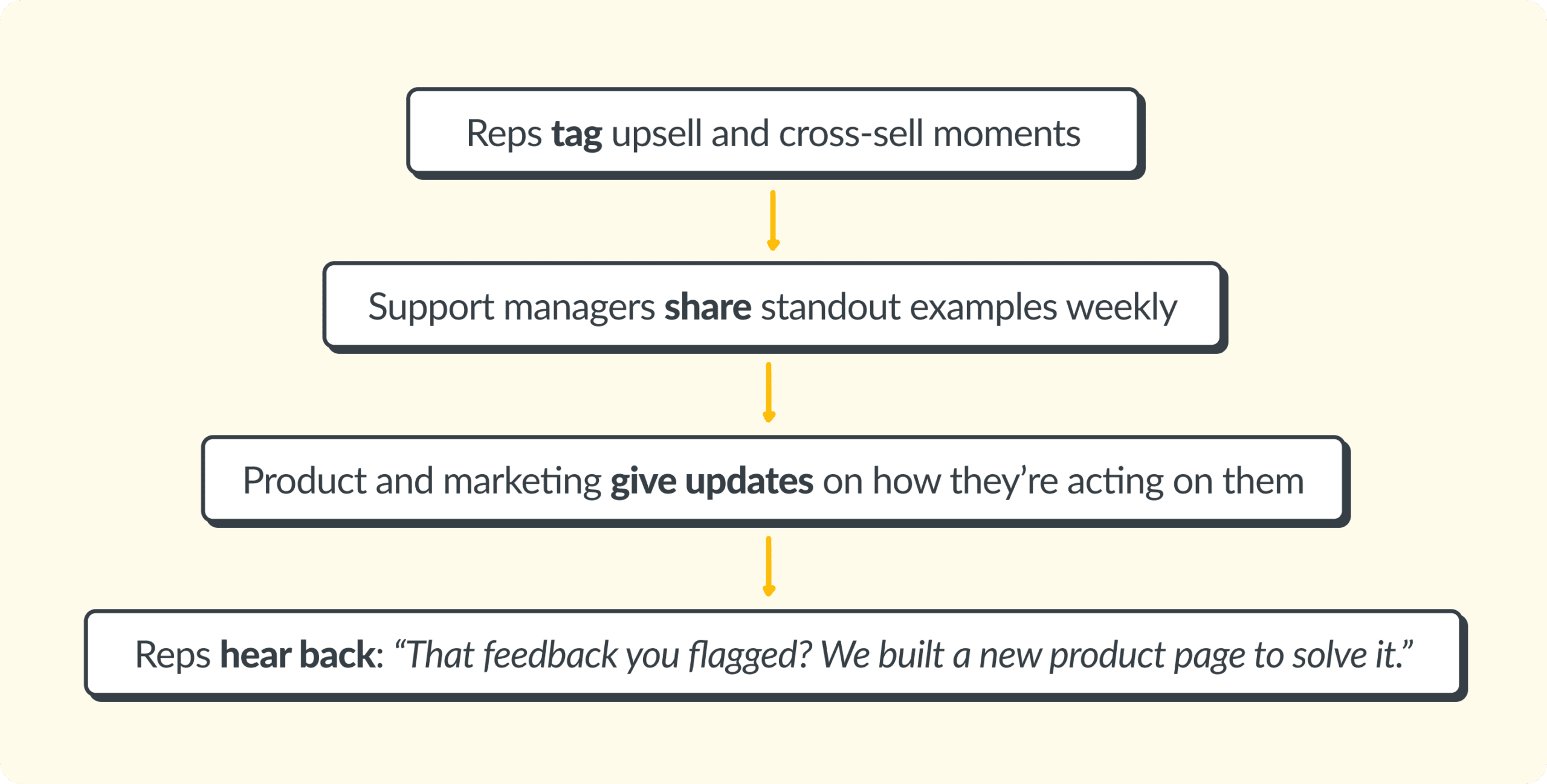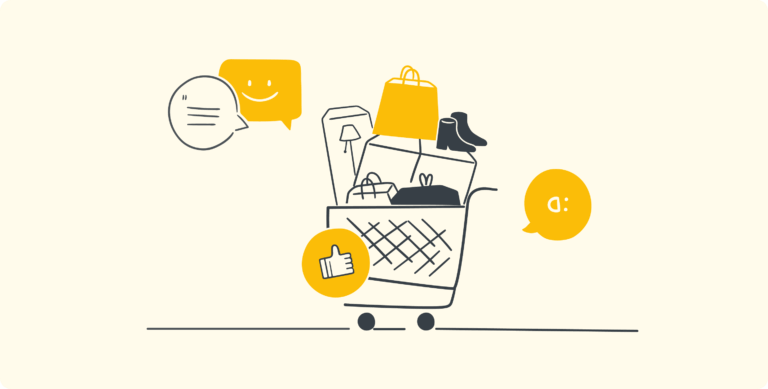Upselling and cross-selling can increase revenue by 10–30% without raising your ad spend.
But in practice, most strategies fall flat.
The offers often come too early or too late. They show up in the wrong context, or they recommend something that doesn’t quite fit.
What’s missing is feedback.
What are upselling and cross-selling based on?
- Upselling is about upgrading. It means you offer a higher-tier product or a more complete version of what the customer already wants.
- Cross-selling is about complementing. You suggest useful add-ons or items that pair well with the current purchase.
Example — A shopper picks out a basic foundation. You recommend the long-wear formula with added skincare benefits and SPF (upsell). Then you suggest the matching primer or setting spray to complete the routine (cross-sell).
Too many sales agents follow a static script, and that makes the customer feel like they’re being pushed, not helped. Most customers are used to impersonal pitches that miss the mark. It makes them tune out. The moment passes.
You must uncover and meet real customer needs if you want to overcome shopper apathy.
Pay attention to the words customers use in support conversations:
- “Is there a version with more storage?”
- “I thought it came with a case.”
- “This works, but I’d prefer something sturdier.”
- “I didn’t realize it didn’t come with the applicator.”
- “Would’ve been perfect if it came in black.”
These comments and questions reveal shoppers’ needs, preferences, and frustrations. And they point directly to better product recommendations.
What your customers are already telling you
Many companies collect feedback without utilizing it to its full potential.
Customer satisfaction surveys are often treated as health checks or compliance metrics. But if you delve into the responses, you find out how your customers think, what they value, and where your products fall short.
That’s where upsell and cross-selling opportunities lie. To uncover those opportunities, don’t stop at the score. Use follow-up questions like “Why did you choose that rating?” or “Is there anything we could’ve done better?”
This turns a number into a narrative, and it points to buying intent your team can act on.
CSAT (Customer Satisfaction Score)
What it measures — How satisfied a customer feels after an interaction or event
When it’s used — Post-purchase, after support tickets, live chat
How it helps — Low scores highlight issues. High scores highlight momentum. Comments often contain upgrade signals like “I wish it was bigger” or “this worked perfectly, I’ll probably buy another.”
Example — A customer gives a 4/5 after chatting with support. In the comment, he mentions liking the product but wanting more color options. That’s both feedback and a buying signal.
CES (Customer Effort Score)
What it measures — How easy it was to complete a task
When it’s used — After checkout, onboarding, or solving an issue
How it helps — High-effort scores reveal points of confusion. Customers may be open to higher-tier options if they simplify the experience.
Example — A customer struggles to assemble a DIY product and leaves a high-effort rating. Your team could recommend a pre-assembled alternative in the future.
NPS (Net Promoter Score)
What it measures — How likely a customer is to recommend your brand
When it’s used — Periodically, across lifecycle stages
How it helps — Detractors and passives often explain what’s missing. Promoters may ask for additional features or accessories in their comments, and these are ideal cross-selling triggers.
Example — A promoter writes, “Love it, but wish it had a refill pack.” That tells you what you can do to strengthen her loyalty.
Read more: NPS promoters, passives, and detractors
5-star surveys
What it measures — General satisfaction with a product, service, or interaction
When it’s used — Often post-purchase or post-support
How it helps — It captures quick, honest reactions that often reveal what’s missing. The star rating shows sentiment, but the comment tells you what the customer really wanted.
Example — A 3-star review that says “Good, but runs out quickly” can inform a value bundle, refill option, or auto-replenishment offer.
How to spot upsell/cross-sell opportunities in feedback
Not all feedback is created equal. Some customers tell you exactly what they want. Others only hint at it. Sometimes, you don’t notice an opportunity until you zoom out.
Here is what to look for:
1. Direct requests
- “Do you have this in a larger size?”
- “Is there a version with more features?”
- “Can I add a warranty?”
A customer is asking for more. The intent is already there. Your job is simply to respond with the right offer.
How to respond
- Point them to the upgraded version (upsell)
- Suggest a bundle that includes what they asked for (cross-sell)
- Follow up with a post-interaction email offering exactly what they were missing
Train reps to treat these moments as requests, not just questions. If someone says, “I wish it came with…”, they’re already halfway sold.
2. Indirect signals
- “I didn’t expect to assemble it myself.”
- “It’s a bit underpowered for daily use.”
- “I thought it came with batteries.”
These comments often appear in CES survey responses or post-delivery followups. They don’t ask for more directly, but they reveal a mismatch between expectations and the product. The right upsell feels less like a pitch and more like a solution.
How to respond
- Recommend a more complete or premium option
- Suggest an add-on that solves the friction
- Use these signals to improve product page clarity or checkout suggestions
Example — If feedback indicates the dog bed flattens quickly, recommend the orthopedic version upfront, or bundle in a washable insert to extend its lifespan and pet comfort.
3. Repeated patterns
- Dozens of customers asking about refills
- Multiple NPS comments saying the product isn’t durable
- Support tickets repeatedly requesting the same feature
One request is an opinion. Ten is a trend. Repetition is the clearest sign you’re missing a chance to improve the experience or grow the cart.
How to respond
- Add the missing item to your product catalog
- Build a bundle around the frequently mentioned combination
- Alert the product team and test upgrades based on real demand
Building a feedback-based upsell and cross-sell culture across departments
Customer service teams are in the best position to spot buying signals. But too often, they’re trained only to resolve issues, not to make recommendations.
The goal isn’t to turn agents into salespeople, but to give them the tools, confidence, and permission to speak up when they see a better fit or a missed opportunity.
If a customer asks, “Do you think this is right for me?”, that’s a show of trust. A thoughtful upsell or cross-sell suggestion doesn’t feel pushy here!
But many upselling and cross-selling opportunities are more complex. They require spotting patterns and sharing them across teams.
That’s why you need a simple system for capturing and sharing feedback.
Internal tagging
Support platforms like Zendesk, Gorgias, and Intercom allow custom tags to be added to resolved tickets. Build a short, focused list that helps your team flag sales-related signals as they come up.
For example:
- upgrade-request
- missing-accessory
- premium-fit
- cross-sell-opportunity
- repeated-ask
Simplesat’s Topics feature uses AI to automatically tag feedback by theme and sentiment. This makes it easier to spot upgrade requests or missed opportunities at scale!
Weekly reviews
Make someone responsible for reviewing those tags once a week. This isn’t a big project; it’s a 15-minute scan. But it can help you strike gold.
Look for frequently requested upgrades, add-ons that cause confusion when missing, etc. Also take note of support moments that led to additional purchases.
Each week, make a roundup of observations that other teams need to know about.
- “Most common request from chat: refills or larger size.”
- “CSAT comments: customers didn’t realize batteries weren’t included.”
- “Frequent ask: Is there a more durable version?”
- “Multiple support tickets: product not compatible with X.”
Break down information silos
Everyone benefits when they know what customers are actually asking for. Sometimes, one clear trend is all it takes to justify a new bundle, page update, or campaign.
Product teams can spot feature gaps, missing variants, or recurring complaints that signal that it’s time to upgrade or simplify an item.
Marketing can adjust messaging to clarify what’s included, manage expectations, or highlight benefits that resonate most.
Merchandising can rework how items are bundled or displayed, add compatibility notes, or make cross-sell suggestions more obvious at checkout.
Build short feedback loops between teams

When people see feedback turning into action, they stay engaged!
Read more: How to make the most out of feedback in every department
Track the wins
Celebrate and analyze moments like this:
- “Didn’t realize I needed a charger. Glad support pointed me to the starter kit.”
- “Too small for everyday use. Ended up buying the bigger pack and it’s perfect.”
- “Almost skipped the couch cover, but it’s saved me from so many spills! Totally worth it!”
These happy customers are proof that listening drives better outcomes. Your team can stay one step ahead by taking note of what works.
Empathy and trust-building are crucial
Zappos analyzed over 800,000 customer comments across different channels. One finding stood out: customer trust is decreasing across industries.
Most customers don’t believe that brands have their greatest interests at heart. This understandably decreases willingness to buy more products.
“There’s the myth that personalizing the customer experience just takes collecting lots of data. The reality is that meaningful personalization involves understanding customers on a psychological level. Someone buying a grill, for example, doesn’t want recommendations of other grills right after the purchase. Rather, what about asking the customer why they’re buying the grill, and making relevant recommendations for related items?” — the National Retail Federation
Poorly timed upselling/cross-selling offers erode customer relationships. Generic suggestions send the message that you’re not really listening. And once trust is gone, it’s hard to win back.
But when done well, upselling and cross-selling feel helpful. They show that you understand what the customer actually needs, maybe even before they say it.
Listen closely, act thoughtfully, and let the feedback shape the selling.
About Simplesat: Simplesat is the leading omnichannel survey app designed to enhance customer feedback management across various platforms, including Zendesk, Salesforce, and Gladly. Trusted by businesses worldwide, Simplesat delivers actionable insights that drive business growth and customer satisfaction.




